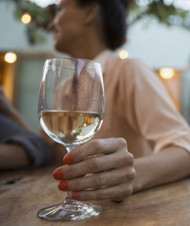WINE NUTRITION
3rd Jun 2017
Based on my understanding and research about wine, grapes, alcohol and sugar, this is my rendition of NUTRITION IN WINE.
 First off, let’s get this straight. WINE IS NUTRITIOUS. Don’t forget that premise. Most of the nutritionists that I know drink wine. Most of the doctors that I know drink wine. All of the nurses that I know drink wine. That should tell us something. If a doctor tells you that wine is not good for you, then remind him what the great philosopher, Willie Nelson said:
First off, let’s get this straight. WINE IS NUTRITIOUS. Don’t forget that premise. Most of the nutritionists that I know drink wine. Most of the doctors that I know drink wine. All of the nurses that I know drink wine. That should tell us something. If a doctor tells you that wine is not good for you, then remind him what the great philosopher, Willie Nelson said:
‘well there’s more old drunks than there are old doctors, so I guess we’d better have another round’.
I was asked to render calorie count and nutritional data on M6 wines for a restaurant carrying some of our wines. That made me curious as to what other related research has determined. You can spin a story any way you want, but wine indeed has its benefits.

Generally speaking, grapes with certain water content, nutritional qualities, acids and sugar are crushed into must used to make wine. Yeast is added to the must and converts (almost) all sugar into CO2 and alcohol. The CO2 is either retained for frizzante style or sparkling wine or released. Either way, there is no nutritional value in CO2 unless you are a plant. Water makes up a large portion of a glass of wine. Crediting all of the nutrients to the grape/wine, the water is also without nutritional value.
Through filtering, all of the yeast and its residue is filtered out of the must at bottling (along with other stuff). For dry wine, the nutrition comes from the remaining grape characteristics and alcohol. Pure alcohol, Ethanol, (don’t be drinking Methanol. If you do there is no need to finish this article) contains roughly 160 calories per ounce. Like water, no other nutritional value is attributed to alcohol. Therefore, the only nutritional value in alcohol is calories (7 calories per gram).
Depending on the alcohol content of a particular wine (ABV), the calorie count is easily calculated; i.e. 14% ABV wine in a 5 ounce pour contains (160 calories x 14% x 5 oz =) 112 calories. If the wine has a lower ABV, then the calories will be lower. An official serving of wine is considered to be 5 oz = 150 ml. If your serving is more generous, then you will have to do the math yourself. For a more accurate calculation, may I suggest that you do said math before having your second generous pour.
To review, a 14% ABV dry wine is made up of roughly 85% water, 14% alcohol, (>)1% sugars vitamins, minerals, and other nutrients. Sodium, potassium, magnesium, iron, certain B vitamins, calcium and protein are common, but not in significant amounts. It is worth noting that fat and cholesterol are not present in wine.
Like it or not, most wine contains some sugar. Even a dry wine can contain up to 10 grams/liter (1%) of Residual Sugar. That is not much, but it adds a calorie or two. Sugar is a carbohydrate and its caloric value is 4 calories per gram. Most of us do not easily quantify grams. I relate to teaspoons. Therefore, in the chart below, I’ll illustrate sugar levels in grams/Liter of Residual Sugar (g/L RS) and teaspoons per 5 oz glass (tsp). Depending on the classification of your wine, to calculate your calories in a glass (5-ounce pour) of wine, add the caloric value of the alcohol to the sugar calories below:
| Dry | < 10 g/L RS | (< 1/2 tsp) | 0 - 6 cal / glass |
| Off-Dry | 10 - 35 g/L | (1/2 - 1 tsp) | 6 - 21 cal / glass |
| Sweet | 35 - 120 g/L | (1-4 tsp) | 21 - 72 cal / glass |
| Dessert | 120 - 220 g/L RS | (> 4 tsp / glass) | 72 - 130 cal / glass |
For example, our M6 Texas High Plains (dry) Viognier is 14.8% alcohol and contains roughly 0.5% residual sugar. Therefore the calories in glass would be (160 x 14.8% x 5) + (0.75 gr x 4) = 118.4 + 3 = 121.4 calories per glass.

Our M6 2014 Cabernet Sauvignon is 13.6 % ABV and Dry. A glass of M6 cab contains roughly 112 calories.
You may correctly surmise from this content that alcohol (7 cal/gram) is primarily responsible for calories rather than sugar (4 cal/gram). So if you like sweet wine, don’t beat yourself up. Our Blue Norther is 12.5% ABV and 40 g/L RS. 124 calories for a serving of Blue Norther is only TWO more calories than our Viognier.
Also remember that all wines contain sulphite. Sulphite occurs naturally. It is also added to most wine to extend its shelf life. Red and White wine contains antioxidents and flavonoids. Red wines contain tannins from the grape skins that add wonderful color and characteristics. Reds also contain polyphenols. According to research, resveratrol which is a polyphenol found in red wine, might be beneficial in protecting the lining of blood vessels in your heart.
If this information sounds like it is above my pay grade, then you are correct. I have found a lot of research about wine nutrition and have tried to summarize what I have learned. Wine in moderation has been associated with healthy living for centuries.

